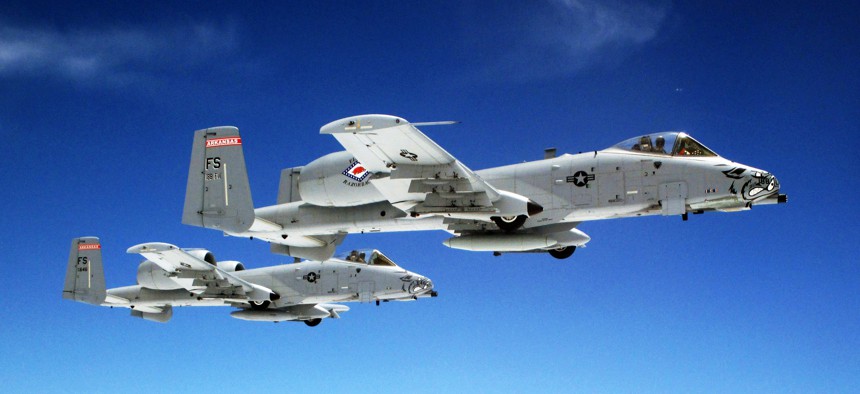
A pair of Air Force A-10 Thunderbolt II aircraft fly in formation June, 7, 2014 over Kansas. U.S. Department of Defense photo by Senior Airman Sierra Dopfel
A-10s Are Heading Back to War, This Time In Syria
Pentagon confirms Hawgs’ arrival in Turkey; details new deconfliction deal with Russia.
The A-10 is going to war once again — this time in Syria, where its particular brand of close-air support is needed to augment the faster jets that have been bombing ISIS targets for more than a year.
“There are A-10s arriving in Incirlik [Air Base], and I don’t have the exact number...and this was part of a regular rotation that was planned,” said Pentagon spokesman Peter Cook.
It's not the first time the Thunderbolt II has been sent to fight ISIS — last November, several Indiana Air National Guard were sent to help out in Iraq — but this latest deployment is sure to add fuel to the long-simmering debate over the Air Force’s push to retire the cheap, slow-flying, highly effective attack planes.
Related: The Air Force’s Argument for Retiring the A-10 Makes No Sense
Cook also said that U.S. and Russian defense officials had signed a memorandum of understanding that lays out safe-conduct measures for each nation’s pilots over Syria.
“The [memorandum of understanding] includes specific protocols for aircrews to follow,” he said. “These protocols include maintaining professional airmanship at all times, the use of specific communication frequencies, and the establishment of a communication line on the ground.”
Cook stressed the memo should not be viewed as an “agreement” because Washington does not agree with Moscow’s actions in the Syrian crisis.
“The MoU does not establish zones of cooperation, intelligence sharing or any sharing of target information in Syria,” he said. “The discussions through which this MoU was developed do not constitute U.S. cooperation or support for Russia’s policy or actions in Syria. In fact, far from it. We continue to believe that Russia’s strategy in Syria is counterproductive. And their support for the Assad regime will only make Syria’s civil war worse.”
Both nations will also form a working group to ensure the measures are followed, Cook added.
Meantime, while the Pentagon laid out these new safe conduct measures, the Russian defense ministry released footage of its jets circling what appears to be a U.S. Reaper drone in the Syrian skies.